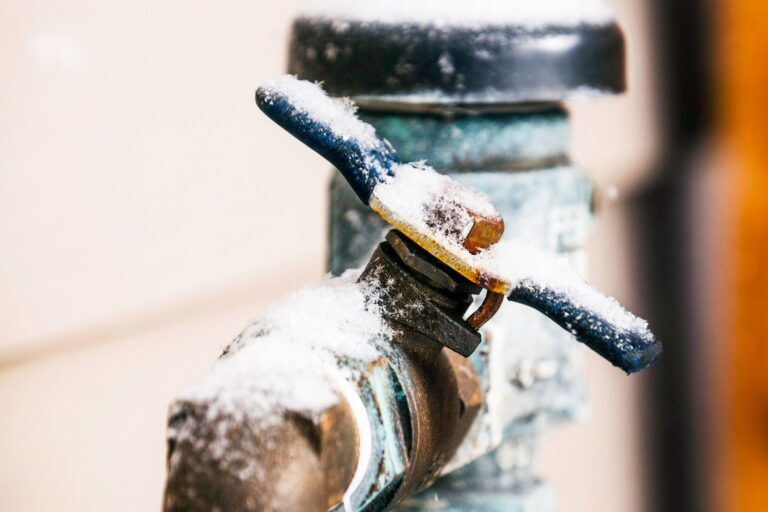Frozen pipes are a common but serious winter plumbing issue. When water freezes inside your pipes, it expands and puts extreme pressure on the pipe walls. If left untreated, a frozen pipe can burst—leading to extensive water damage, mold growth, and costly repairs. In this article, we’ll explain how to safely identify, thaw, and plumb a frozen pipe, as well as offer essential tips for preventing freezing in the future.
Signs of a Frozen Pipe
Before you can fix a frozen pipe, you need to identify it. Some of the most common signs include:
- Little or no water flow from a faucet or shower
- Frost visible on exposed pipes
- Unusual clanking or gurgling sounds when running water
- Bulging pipe sections that appear distorted or cracked
- Water leaks or pooling after a pipe thaws (a burst has occurred)
Frozen pipes most often occur in unheated areas such as basements, crawl spaces, attics, garages, and exterior walls.
Step 1: Locate the Frozen Pipe
Turn on all your faucets to find out which ones aren’t working. Trace those water lines back to unheated areas to locate the freeze. If your entire home has no water, the main supply line might be frozen.
Look for:
- Pipes near exterior walls
- Exposed plumbing in basements or attics
- Spots where insulation is missing
Once you find the frozen section, it’s time to get to work.
Step 2: Shut Off the Water Supply
Before thawing any pipe, turn off the water supply to prevent flooding in case the pipe bursts during the thawing process. Locate the main shutoff valve for your home, usually found in the basement, utility closet, or near the water meter.
Also, open the affected faucet to allow water and steam to escape as the ice melts.
Step 3: Safely Thaw the Frozen Pipe
Never use open flames to thaw pipes. Instead, use one of the following safe methods:
A. Hair Dryer
Blow warm air directly onto the frozen section of the pipe. Work slowly and evenly, starting from the faucet end and moving toward the frozen area. This allows melting ice to escape gradually.
B. Heating Pad or Electric Pipe Thawer
Wrap the pipe with an electric heating pad and set it to medium or high. These are ideal for tight spaces.
C. Towels Soaked in Hot Water
Wrap hot, damp towels around the pipe and replace them as they cool. This method is slower but effective when electrical options aren’t available.
D. Space Heater
Place a portable space heater in the room near the frozen pipe—never too close—and monitor it closely to prevent fire hazards.
Continue heating until full water pressure is restored and the pipe feels warm to the touch.
Step 4: Inspect and Repair Damage
Once the pipe is thawed, check for cracks or leaks. If you discover a burst pipe, take the following steps:
- Keep the water shut off to prevent more flooding
- Use a pipe clamp or repair sleeve as a temporary fix
- Dry any water-damaged areas to prevent mold
- Call a licensed plumber for a permanent repair or pipe replacement
If the frozen section was inside the wall, you may need to cut drywall to access and repair it.
Step 5: Prevent Future Pipe Freezes
Now that you’ve dealt with a frozen pipe, take action to prevent it from happening again.
A. Insulate Pipes
Wrap pipes with foam pipe insulation, especially in basements, garages, crawl spaces, and exterior walls. For added protection, use heat tape or heat cables.
B. Seal Gaps and Cracks
Use caulk or spray foam to seal holes in exterior walls near pipes where cold air can enter.
C. Keep Indoor Temperatures Stable
Maintain your thermostat at at least 55°F (13°C), even when you’re away from home. Keep cabinet doors open under sinks to let warm air circulate.
D. Let Faucets Drip
During severe cold snaps, let a trickle of cold water run from faucets connected to exposed pipes. Moving water is less likely to freeze.
E. Winterize Vacant Homes
If you’ll be away during winter, shut off the main water supply and drain the plumbing system. Use antifreeze in drains and toilets as an extra safeguard.
When to Call a Professional Plumber
If you can’t locate the frozen section, are unable to thaw it, or discover significant pipe damage, it’s time to call a licensed plumber. A professional has the tools to safely thaw pipes, detect hidden leaks, and replace damaged sections quickly and safely.
Frozen pipes are an emergency situation in many climates, and early intervention can prevent major repair bills.
Final Thoughts
Plumbing company Carmel Indiana a frozen pipe involves more than just applying heat—it requires careful inspection, safe thawing methods, and immediate response if a pipe bursts. The key to long-term success is prevention. With a few smart steps like insulation, sealing air leaks, and maintaining indoor warmth, you can drastically reduce the risk of frozen pipes in the future.


